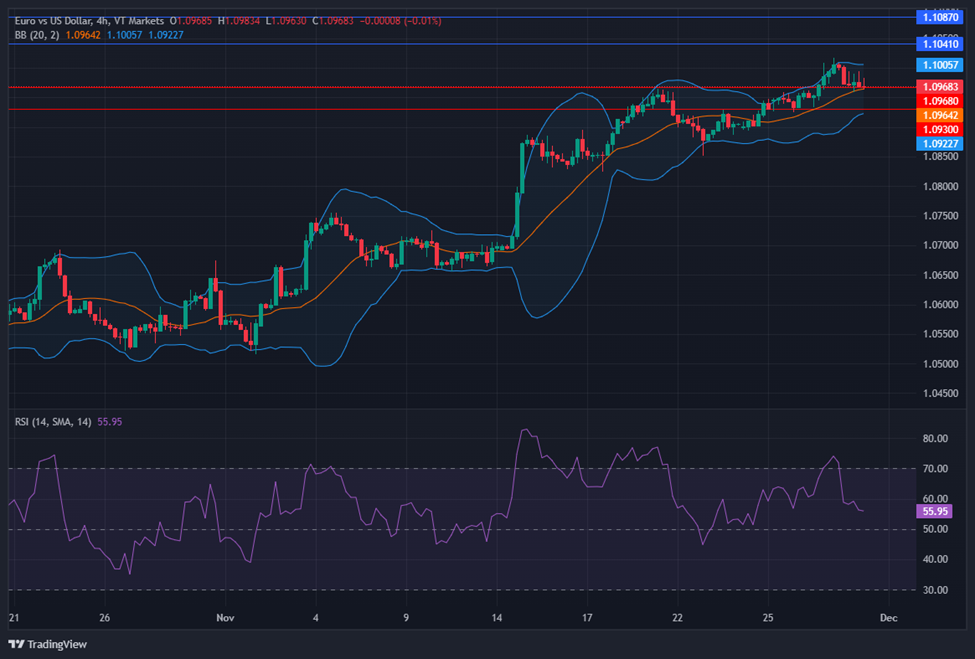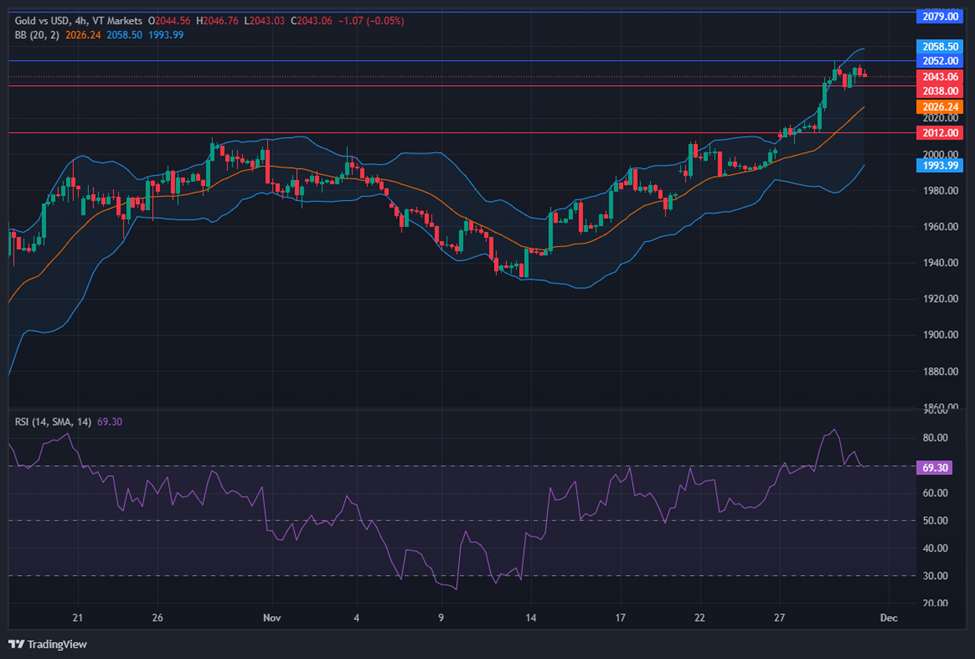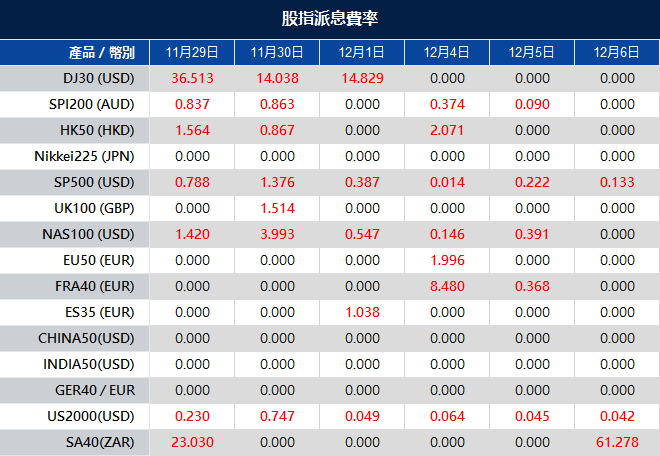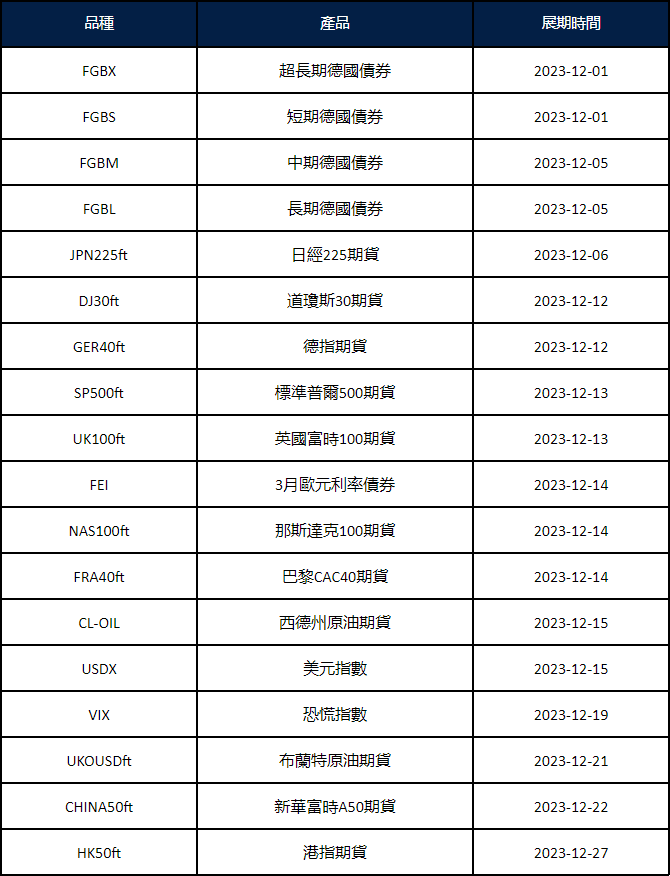Following a five-week winning streak, stock markets experienced a decline, prompting investor worries about potential overvaluation. Major indices, including the Dow Jones Industrial Average, S&P 500, and Nasdaq Composite, dropped due to selling pressure on Big Tech stocks. However, Bitcoin hit a 19-month high while gold reached unprecedented levels, benefiting companies like Marathon Digital, Riot Platforms, MicroStrategy, and Coinbase. The market shift away from tech shares, despite the S&P 500 hitting highs, led to speculation about future rate cuts from central banks, especially as Federal Reserve Chairman Jerome Powell attempted to moderate expectations. European and Asia-Pacific markets reflected mixed performances amid predictions of interest rate cuts in 2024. Currency markets saw significant movements, with the dollar index surging and the euro facing downward pressure against the dollar due to Treasury yield recoveries and market sentiment regarding potential ECB and Fed rate cuts. Meanwhile, gold prices dropped significantly following the resurgence in Treasury yields and a strengthening dollar.
Stock Market Updates
Stocks experienced a dip after a continuous five-week winning streak, raising concerns among investors about potential overvaluation in the market. The Dow Jones Industrial Average closed with a 0.11% drop, the S&P 500 fell by 0.54%, and the Nasdaq Composite declined by 0.84%, attributed to the selling of Big Tech shares, which had been driving the market’s gains. Conversely, Bitcoin surged past $41,000, hitting a 19-month high, while gold reached its highest intraday level ever, leading to gains for companies like Marathon Digital, Riot Platforms, MicroStrategy, and Coinbase.
The pullback was marked by a shift away from sectors that had been driving market growth for almost a year, particularly technology shares. Despite this, the S&P 500 closed at its highest level since March 2022, with year-to-date gains nearing 20%. The Dow and Nasdaq also experienced significant increases in 2023. Speculation about future rate cuts from major central banks persisted, even as Federal Reserve Chairman Jerome Powell attempted to temper these expectations.
In Europe, markets saw a mixed performance, largely lower, reflecting a global pause in the recent rally amid predictions of interest rate cuts from major central banks in 2024. Gold prices surged, hitting a record high, attributed to geopolitical uncertainty, a potentially weaker U.S. dollar, and anticipated interest rate cuts in the coming year. In Asia-Pacific, markets were also mixed as investors awaited upcoming economic data and crucial inflation readings later in the week.

Data by Bloomberg
On Monday, the market experienced a slight overall decline of 0.54%. Real Estate stood out with a positive increase of 0.53%, followed by Health Care and Industrials with gains of 0.21% and 0.20%, respectively. Conversely, Materials took a significant hit, dropping by 1.19%, while Information Technology and Communication Services also experienced notable declines of 1.31% and 1.37%, respectively. Financials remained relatively stable, showing no change, and other sectors like Utilities, Energy, and Consumer Discretionary saw moderate decreases ranging from 0.39% to 0.46%.
Currency Market Updates
The currency market experienced significant movements, particularly in the dollar index, which surged by 0.6%. This rise was attributed to the recovery of Treasury yields from their previous substantial decline in October and November. The upcoming release of crucial U.S. data, coupled with the anticipation of the Federal Reserve meeting, heightened market expectations regarding potential rate cuts by the European Central Bank (ECB) in the following year. Concerns persisted around the Eurozone’s largest economy due to a recent court ruling, further contributing to the speculation of potential ECB rate cuts. The dollar’s momentum was primarily driven by the rebound of 2-year Treasury yields, which recovered a portion of their previous decline, alongside market sentiments that favored possible Fed rate cuts in 2024 unless incoming U.S. economic data alters these expectations.
Meanwhile, the euro faced downward pressure, declining by 0.6% against the dollar, as increasing Treasury yields outweighed minimal gains in bund yields. The EUR/USD pair breached key support levels, including the 200-day moving average line, signaling potential further downside. Market indicators highlighted a decrease in overbought positions, but the expansion of speculative long positions in the market indicated a possibility of continued losses unless forthcoming U.S. data supported expectations of swift Federal Reserve intervention. Additionally, other currencies like the pound sterling saw a contrasting outlook compared to the ECB and Fed, with a potential rate cut by the Bank of England not expected until June, projecting a more conservative 2023 monetary policy. Lastly, gold prices experienced a significant drop, plunging from a record high to $2,020, paralleling the resurgence in Treasury yields and the strengthening dollar.
Picks of the Day Analysis
EUR/USD (4 Hours)
EUR/USD Faces Downward Pressure Amid Rate Cut Speculations and Labor Market Data
The EUR/USD faced its fourth consecutive drop, slipping below the 20-day SMA and hovering above the 1.0800 mark as the US Dollar gained strength before pivotal labor market data. Speculation around the ECB potentially cutting rates before the Fed intensified the downward trend, retracting the Euro from recent highs above 1.1000. Despite the descent, the movement seems somewhat exaggerated, with expected sustained volatility. Market focus shifts to key releases including Eurostat’s PPI and PMIs, alongside US labor reports such as JOLTS, ISM Services PMI, ADP employment data, Jobless Claims, and Nonfarm Payrolls expected later in the week.

On Monday, the EUR/USD experienced a downward movement, creating a push to the lower band of the Bollinger Bands. Currently, the price moving slightly above the lower band, suggesting a potential upward movement, potentially reaching the middle band before goes back lower. Notably, the Relative Strength Index (RSI) maintains its position at 31, signaling a bearish outlook for this currency pair.
Resistance: 1.0880, 1.0945
Support: 1.0835, 1.0760
XAU/USD (4 Hours)
XAU/USD Volatility: Navigating Unpredictable Swings Amidst Economic Indicators
Gold spot prices surged to a record high of approximately $2,150, later correcting sharply below $2,040, in a week marked by erratic fluctuations. The upcoming US labor market data, central bank meetings, and Consumer Price Index contribute to the uncertain landscape. Despite a Federal Reserve tone suggesting hawkishness, Gold surged, possibly fueled by expectations of rate cuts. However, the subsequent pullback hints at a potential overestimation of rate cut probabilities. The market’s movements seem more reactive to sentiment shifts than distinct fundamentals, lacking a clear catalyst for its rally or the subsequent sharp decline. The rise in US yields and Dollar strength on Monday only partially explain the magnitude of Gold’s unpredictability.

On Monday, XAU/USD moved lower after reaching an all-time high of $2,150 but subsequently experienced another strong downward movement, returning to around the $2,030 level. This movement resulted in high volatility, pushing the price beyond both the upper and lower bands of the Bollinger Bands. The current movement suggests a potential upward trend, possibly returning to the middle band. The Relative Strength Index (RSI) stands below 43, indicating a bearish yet neutral sentiment for this pair.
Resistance: $2,049, $2,072
Support: $2,025, $2,006
Economic Data
| Currency | Data | Time (GMT + 8) | Forecast |
|---|---|---|---|
| AUD | Cash Rate | 11:30 | 4.35% |
| AUD | RBA Rate Statement | 11:30 | |
| USD | ISM Services PMI | 23:00 | 52.2 |
| USD | JOLTS Job Openings | 23:00 | 9.31M |
















